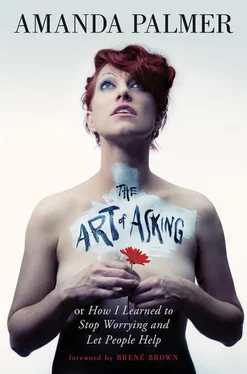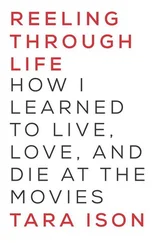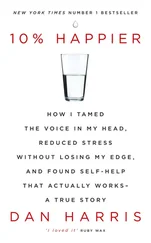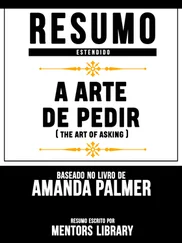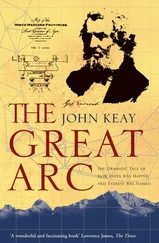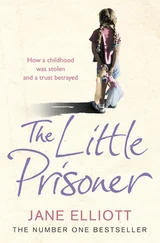I didn’t want to force people to help me. I wanted to let them.
• • •
They say: What’s the harm in asking?
But asking can hurt.
When I was just breaking ground on this book, I was on tour and found myself staying with Duncan, one of my very distant European relatives, one night while everybody else camped in the tour bus. We were enjoying a late breakfast on his sunny back porch, and he asked what I was scribbling in my journal. I told him that I was thinking about the difference between “asking” and “begging.”
Asking… Duncan said. Asking. Hm. That’s interesting. I’m a person who really doesn’t like to ask for things. And the funny thing is, the less you like asking, the worse off you can be when you finally do .
What do you mean?
I’ll tell you a story. My mother and my aunt were in this awful feud , he began, pouring milk into his second cup of coffee. When my grandmother died, she left an antique rosary to my mother, who felt she deserved it because she’d converted to Catholicism when she married. But my aunt was an antiques dealer and apparently had expressed an interest in it, and my grandmother had promised it to her, and blah blah blah… you get the picture. Fury on both sides. They didn’t speak for three years. Can you imagine? And when my mother started battling cancer, I suffered watching them not talk for another year, while my mother got weaker, until I finally found the nerve to call my aunt and say, “Listen. I’ve never asked for anything from you, but now I am, with everything I’ve got. Call my mother. Please, just pick up the phone and smooth it over, apologize even if you feel you’re lying. She’s dying and this is helping kill her. You don’t even have to do it for her. I’m asking you to do it for me.”
And do you know what she said?
I shook my head.
She said no .
I let out a sigh.
It was so hard to ask , Duncan said. I never ask anyone for anything. And I’d finally asked .
He was quiet for a second.
That answer, Amanda… it crushed me .
• • •
Around the time the label freed me, I was still skeptical about Twitter, which I thought of as the social media tool that people used to share what they’d had for breakfast.
A few months later, I was in Austin for the SXSW music conference when Neil and Zoë Keating, my touring cellist, dragged me onto the Twitter wagon and gave me a quick lesson, showing me the little box into which you could input your 140 characters of text. I set up the account and told the fans. I twittered a few pictures. Then I dipped my toe in more experimental water, announcing that I would be hosting a pillow fight.
ANYONE IN AUSTIN!?! TODAY. 3:17 PM!!! PILLOW FIGHT. Corner of red river & 6th. TELL EVERYBODY. Bring pillow!
I only had a few thousand followers, but I guessed at least a few dozen of them were at SXSW. I wasn’t giving them a whole lot of warning, though, and I had no idea what to expect. Ten people? Twenty?
At 3:15 p.m. I showed up at the corner of Red River and Sixth Streets with a pillow to find a crowd of around a hundred people—all armed with pillows—milling around. As soon as they saw me, with no words exchanged, we all attacked each other. (Nobody was injured.)
It was AN AMAZING PILLOW FIGHT , I said to Neil, showing him the photos later that night. I wonder if they enjoyed it as much as I did .
Have you checked Twitter? Neil asked.
What do you mean, “checked Twitter”?
Neil started laughing. I hadn’t realized that Twitter allows you to see the people talking to or about you. I’d thought it was simply a one-way communication device. I had been shouting into my Twitter megaphone without realizing, for three weeks, that thousands of people had been responding.
STOP LAUGHING AND SHOW ME HOW TO DO IT , I said.
Neil introduced me to the “mentions” function, and my phone filled up with a list of hundreds of comments, pictures, short videos of pillow fights, thank-yous, and general buzz about the event that had just occurred. After that, I was convinced. I haven’t left Twitter since.
Explaining how I use Twitter to those who’ve never used it is difficult. It’s a blurry Möbius strip of love, help, information, and social-art-life exchange.
Only now does it occur to me that my first official “twittered” flash gig—The Epic SXSW Pillow Fight At Sixth And River—featured no actual music. I just twittered, hit my fans with pillows, hugged them, and took off. But I didn’t bother to play any songs, and nobody seemed to mind much. They just seemed deliriously happy to be part of something so sudden and surprising. Plus, how could I play music spontaneously in the street? I’m a pianist.
I started playing the piano when I was three—because there it was, in the house—and since then I’ve been a generally monogamous instrumentalist. Occasional fantasies of learning how to play the cello, the guitar, and the acoustic bass have all been left unrealized.
Around the time I discovered the joys of Twitter, I bought a twenty-dollar wooden red ukulele with a plastic fretboard—the world’s smallest, cutest, easiest instrument—as a gag for a friend’s benefit at a small nightclub. In one short evening, I taught myself to play “Creep” by Radiohead, looking up the chords on the Internet. Instead of playing on the nightclub stage, I hopped up onto the bar, and then hopped down to weave through the crowd, playing my ukulele—truth be told—pretty badly. I thought my affair with the instrument would end there, but during that five-minute performance, I was amazed at the power that one little mini-guitar could wield.
Playing the song that night felt like a gimmick, but that summer, I toted the ukulele around with me, for kicks. Cyndi Lauper—my childhood hero (eight-year-old me was beside herself)—invited The Dresden Dolls to open for her on a summer package tour called True Colors, the proceeds of which would benefit the Matthew Shepard Foundation. Almost every night of the tour, I did a quick busking experiment and played “Creep” by Radiohead, still the only song I knew, in the parking lot or the lobby of the venue, with a hat at my feet. I liked surprising people, and they laughed, applauded, and threw in dollars and change. The collected take from the hat went to the foundation, and there it was again, that feeling:
I can play this instrument for people ANYWHERE, as long as it’s not raining!
In a field! In an alleyway! On the bus!! On a beach!!! In a closet!!!
People will listen to me sing, and I don’t need a stage!
I will never have to be enslaved behind a piano again!
I hadn’t realized how limiting the piano had been, but now that I knew, I’d had it. I decided to start dating other instruments.
This combination of Ukulele Freedom and Twitter Freedom led to the birth of the Ninja Gig, which was the name I gave the flash events I started creating once I realized how easy it was to whip a crowd up to any place at any time. Before and after official gigs, on off days when I was in the mood, or when I was visiting cities where I didn’t have any official gigs planned, I could summon a crowd using Twitter on only a few hours’ notice.
There’s something uniquely thrilling about conjuring up a crowd of five hundred people and watching an instant free festival sprout up before your very eyes in a public place, but it took me a few years of bouncing between official gigs and ninja ones to realize what really drew me to the latter: I felt like I was in control of my life again. I had missed the freedom of the street.
Читать дальше
